#langstroth
Text

Still here!
#bees#beekeeper#beekeeping#fox#talks#honeybee#honeybees#honeycomb#honey#bee#hive#hives#long langstroth#langstroth#window#windows#access#door#natural#nature#bug#bugs#insect#insects
41 notes
·
View notes
Text
Lorenzo Langstroth unvarnished

Lorenzo Langstroth, 1890. From Langstroth on the hive & honey bee, rev. by Dadant. 1892.
December 25th, Christmas Day, is a day for sharing and giving. It also happens to be the birthday of a man known as the father of American beekeeping: Lorenzo Langstroth, born Philadelphia, Pennsylvania in 1810. With both happy occasions in mind, Mann Library is pleased to announce a resource that we’re pretty sure students of beekeeping and its history will find a wonderful gift: a fully digitized, searchable copy of Langstroth’s handwritten personal journal. Where a researcher would have once had to make an in-person trip to our special collections reading room to attempt a deciphering of Langstroth’s (infamously difficult to read) handwriting, the journal is now freely available (and actually readable!) as both a digitized version of the original work and in a transcribed form as part of the online Biodiversity Heritage Library.
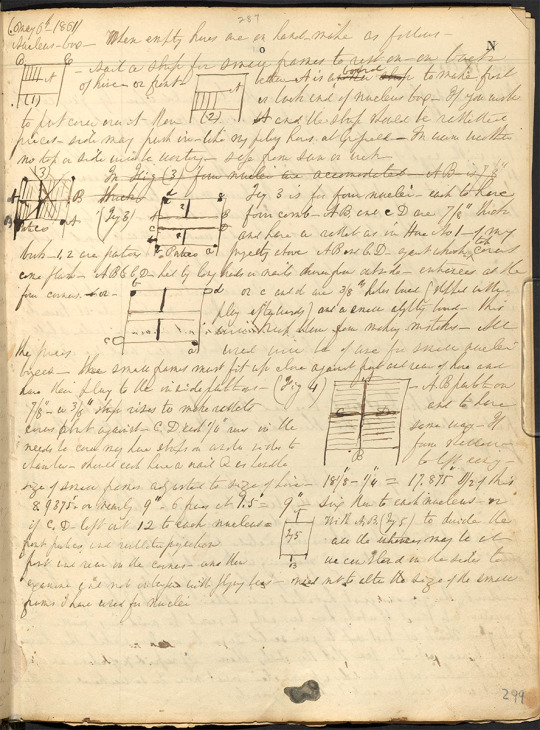
Page from "Journal on matters relating to bees, etc.," unpublished manuscript, Lorenzo Langstroth 1852-1895. in the special collections of Albert R. Mann Library, Cornell University.
For those not yet fully in the know, Lorenzo Langstroth looms large in American beekeeping history thanks to discoveries and inventions he made as a self-taught apiarist, innovations which essentially revolutionized the 19th century practice of beekeeping in North America and facilitated its development into the profitable industry of today. His guide on beekeeping, The Hive and the Honeybee, was first published in 1853 and remains in print even today. Langstroth’s story is also poignantly notable for a reason that you don’t have to a be a beekeeper to appreciate deeply: his struggles with debilitating depression, which stymied many of his professional endeavors. While working intermittently as a pastor and teacher when his mental health allowed, Langstroth found constant, life-affirming inspiration in the bee world he observed closely through the prism of the hives he kept for most of his adult life.
The history of beekeeping stretches back to prehistoric times, but when Langstroth patented his movable frame beehive in 1852 it created a worldwide revolution in the practice of keeping bees. On this page of his journal, we see the exact moment—the “aha” moment—that Langstroth landed on his brilliant insight: the significance of applying the concept of "beespace" to design hives that allow easier harvesting of honey than possible in earlier hive structures. The rest, as they say, is history.
The journal Langstroth kept is a treasure for several reasons. It provides fascinating insight into pivotal moments of beekeeping’s technological history. It is, as well, an intimate view of resilience in face of sometimes devastating mental health challenges. And last but really not least, in the comments and pet peeves that Langstroth also recorded in his ongoing notes-to-self, his off-the-record writing offers a more mundane but no less instructive tour through the day-to-day concerns—from keeping bee hives productive to the vexing challenges of protecting trade secrets and securing patents for promising new discoveries in a timely way—that would have been top-of-mind for any aspiring agricultural entrepreneur of the 19th century.
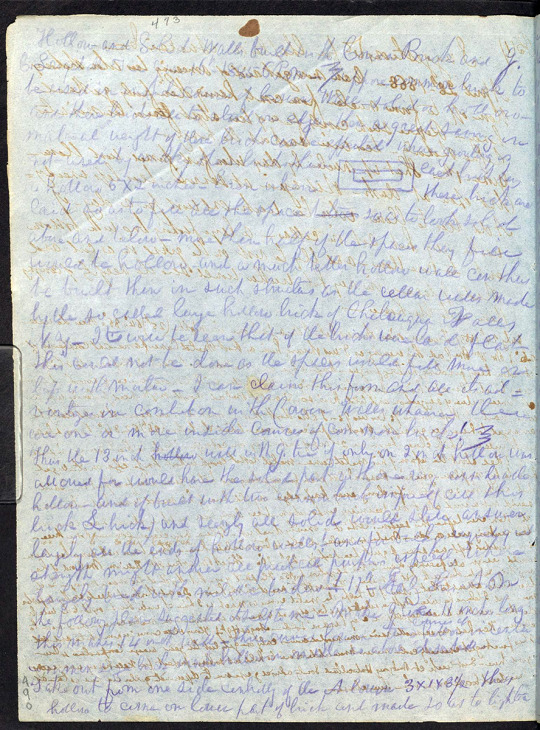
Page from "Journal on matters relating to bees, etc.," unpublished manuscript, Lorenzo Langstroth 1852-1895. in the special collections of Albert R. Mann Library, Cornell University.
The online availability of Langstroth’s journal in both its handwritten and transcribed form has been a work very long in the making. When early 20th century entomologist Everett Franklin Phillipps joined the Cornell faculty 1924, he made it his mission to establish one of the world’s most important collections of beekeeping materials—now known as the E. F. Phillips Collection at Mann Library. Recognizing the importance of one of this collections’ gems—the Langstroth journal—for the beekeeping field, Phillips began the painstaking process of transcribing 600 pages of its cramped, highly slanted script—rendered even more illegible by the frequent ink bleed-through from other pages—into easily readable typescript. The project remained unfinished at the time of Phillips passing in 1951, and others took up the work intermittently over the following decades. But it wasn’t until the epic pandemic-era national lockdown of 2020 that intrepid collections specialist Betsy Elswit finally found herself with the time needed to finish transcribing of the journal's final 200 pages. Thanks to this heroic work, a browse through the work on the Biodiversity Diversity Heritage Library today provides a look at Langstroth’s original writing with a side-by-side view of transcribed, machine-readable text. Thank you Betsy! And thank you, Reverend Langstroth, for persevering through the inspirational highs and deep lows of life to impact the practice of beekeeping so profoundly, and to leave us such a rich record of such remarkable scientific observation and personal achievement.
And with that, we leave you with our best wishes for a good, hope-filled winter holiday season!
#Langstroth#beekeeping#beekeeper#apiculture#mann library#cornell university#rare books#vintage book#archives#mental health#agricultural history#special collections#bees#honey#apiary#honey bees
11 notes
·
View notes
Text
🎨Chris Langstroth

Paintings By Chris Langstroth

Chris Langstroth is an artist with more than 30 years of experience. He paints stunning abstract paintings, and in every in every painting there are vibrant colors.

“I enjoy the physicality of thick paint and use knives to smear on one wet layer over another or to excavate through existing layers. Although I strive for a certain visual plausibility in my work, representational accuracy is not my prime objective” Langstroth explains.






0 notes
Text
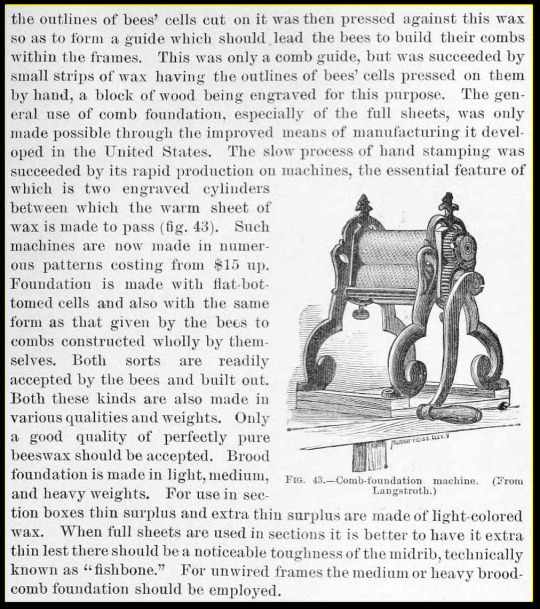
The first attempts to give bees outlines of cells as a basis for comb building were made in Germany.
The top bars of the frames were coated on the underside with beeswax, and a strip of wood having the outlines of bees’ cells cut on it was then pressed against this wax so as to form a guide which should , lead the bees to build their combs within the frames.
This was only a comb guide, but was succeeded by small strips of wax having the outlines of bees’ cells pressed on them by hand, a block of wood being engraved for this purpose.
The general use of comb foundation, especially of the full sheets, was only made possible through the improved means of manufacturing, it developed in the United States. The slow process of hand stamping was succeeded by its rapid production on machines, the essential feature of which is two engraved cylinders between which the warm sheet of wax is made to pass (fig. 43).
Such machines are now made in numerous patterns costing from $15 up.
Foundation is made with flat bottomed cells and also with the same form as that given by the bees to combs constructed wholly by them selves.
Both sorts are readily accepted by the bees and built out.
Both these kinds are also made in various qualities and weights. Only a good quality of perfectly pure beeswax should be accepted.
Brood foundation is made in light, medium, and heavy weights. For use in section boxes thin surplus and extra thin surplus are made of light-colored wax.
When full sheets are used in sections it is better to have it extra thin lest there should be a noticeable toughness of the midrib, technically known as u fishbone.” For unwired frames the medium or heavy brood- comb foundation should be employed.
Until used it is best to keep comb foundation between sheets of paper and well wrapped, since if long exposed to the air the surface of the wax hardens somewhat, but if well packed it may be used years after it was made with almost the same advantage as when first rolled out.
🔥🐝☯💛⛺🔆
Source - THE HONEY BEE:
A MANUAL OF INSTRUCTION IN APICULTURE. BY FRANK BENTON.
0 notes
Photo

If you build it, they will come. . . . #handmadehive #langstroth #diy #10framehive #beehive #savethebees #bees #bee #homesteading #homestead #fieldofdreams #bufforpington (at Wilmington, North Carolina) https://www.instagram.com/p/ChhU5JOOfZU/?igshid=NGJjMDIxMWI=
#handmadehive#langstroth#diy#10framehive#beehive#savethebees#bees#bee#homesteading#homestead#fieldofdreams#bufforpington
1 note
·
View note
Text

Brooding anemone (Epiactis prolifera) covered in offspring
By: Libby McCown & Lovell Langstroth
From: Natural History Magazine
1984
#sea anemone#cnidarian#invertebrate#1984#1980s#Libby McCown Langstroth#Lovell Langstroth#Natural History Magazine
82 notes
·
View notes
Note
I'm sorry you're feeling demoralised at the moment. :( How about "sun(light)", "mountain" and/or "sarcastic" for the WIP meme.
Eh, my exchange fic is not going well, and I am considering scrapping it. Also, I have spent the day trying to shovel mixed snow and ice (mostly ice), which is enough to demoralise anyone. But thank you for the sympathy and the words!
Mountains are mentioned when Major Guthrie is DIRKED:
"That's a Highland dirk," Ewen said, misgiving in his voice.
"Yes. Do you recognise it?"
"No. Even after the Disarming Act, there are dirks enough in these mountains. And not all of them are in Highlander's hands. But mark my words, a Highlander will be blamed, nonetheless."
There is sunlight in the opening chapter of Langstroth on Bees:
I was correct to believe that Holmes was a greater threat to my sleep than his bees: I woke the next morning to find sunlight streaming into the room and Holmes seated on the edge of my bed, grinning down at me.
And oddly enough, it is Holmes who is sarcastic, not Keith. Again from Langstroth on Bees:
Holmes's list, when it arrived the next morning, was thankfully short, and included a somewhat sarcastic offer to shake Hurst’s hand in Trafalgar Square, if I wished it. My reply specified that I would not be satisfied unless the handshake should take place at the man’s club.
12 notes
·
View notes
Text
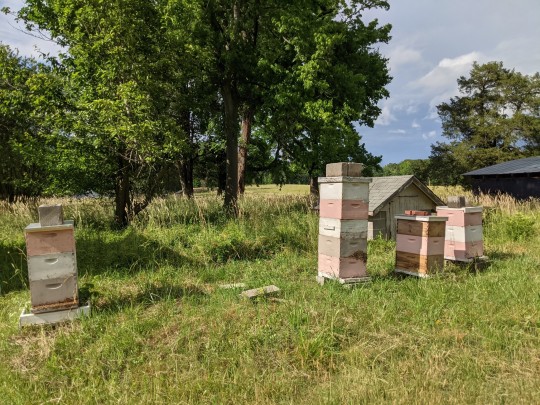
The end of the big honey flow approacheth, and the bees are looking strong! I should get a decent harvest this year, and then the plan is to split that big hive a few ways and support them through (gods willing) making their own new queens. Wild mating cuts what you have in half, of course, but that queen's been too good to not try to replicate her.
15 notes
·
View notes
Text
thinking about getting some warre hives and i wanna have like, magical symbols and seals and such on them but i'm also incredibly tempted to get a wood burner and recreate 16th century woodcut prints on them. like consider what if i just went ham and did Jacob Matham's The Four Elements on my warre hive
#lune croaks#i really like the setup of warre hives better than langstroth hives--i think my ideal would be one of those little top bar ones#they look like they'd be the easiest on your body but the warre hives are easier on the bees. top bars would probably be good for like#breeding i guess#i have some reservations about bare wood hive boxes (which most warre hives are) because of how damp it is out here#but idk. we'll figure it out#the langstroth hives just fell apart over time--no doubt with help from the goddamn carpenter ants
4 notes
·
View notes
Text
Honey coming in full force into the farm
Honey coming in full force into the farm
youtube
#ReefDVMs#RMSpeltz Farm#Bee#bee hive#cover#super#brood box#queen excluder#base#bee keeping#inner cover#bee hive education#langstroth hive#langstroth box#italian bees#dij camera#bee hive parts#understanding bee hive#learning bees#best hive box#best bees#best hive#hive brush#bee hive brush#hive smoker#bee tool#bee hive tool#beginners beekeeping#beekeeping#basic beekeeping
0 notes
Text
WIP Titles Meme
I was tagged by @peridotglimmer (hi! it's nice to see you again, as it were, and I'm glad you're still working on Timeless. I'm not, currently, though I am thinking about them always.) The idea is that one shares the working titles of one's WIPs, and answers any questions that may ensue with snippets or facts. Titles! And, um, not titles.
A Different Kind of Folly
a still and woven blue
Believing the Lovely Idea (rough working title)
Care of Future Times
everything | that has not yet been lost
The Improbable Affair of the Bell That Rang
[Untitled Milquetoast Albatross Spite Thing]
[Untitled Unfridging Case Study]
Wild Barter, a.k.a. Ivanhoe Noir
Winnowing Oar
...why is there so much angst here (rhetorical)?
Then tagging as many people as one has WIPs (eek): with affection and usual caveats, @shredsandpatches, @tollers-and-jack, @tinydooms, @amarguerite, @a-candle-for-sherlock, @counterwiddershins, @educatedinyellow, @herawell, and... I feel as though either I know what other people are writing (so excited for Langstroth on Bees, @sanguinarysanguinity,) or I have forgotten people's handles on here, or they have already been tagged by @letmetellyouaboutmyfeels, so, er, feel free to join on if you're not on here but would like to be?
12 notes
·
View notes
Text
Long time no post! How is everyone??? I moved!
The bees are *mostly* alright based on my most recent “checkup” and I’m only down one and a half colonies that I knew were already weak. One of them I suspect was taken out due to a leak in the lid that made the wood damp and less insulating. They must have left very early in the season because the bottom of the hive was FULL of wax moth cocoons and eggs and cockroach poop and all kinds of nastiness. I scraped it out and didn’t see any sign of lasting mold on the wood though so it mustn’t have been too damp.
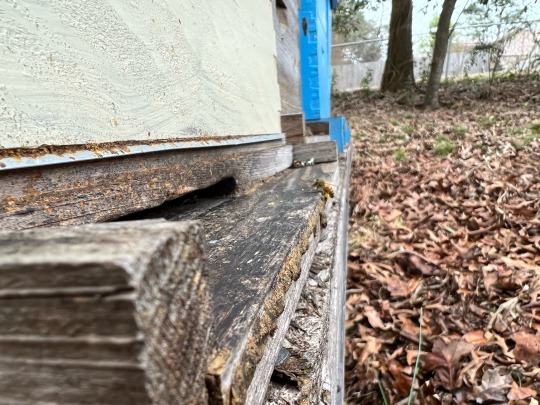
The other four langs are doing just dandy as well. All have enough bees in them to show activity at 50f and overcast so they’re apparently healthy. Already bringing in pollen too!

The super hive seems to be doing incredibly well also! They have propolized up the front of the hive in what I can only presume is an effort to manage air flow and the openness of the entrance. Since I seldom ever check the front 10 frames I suppose that’s alright, though if they are to abscond it will be a chore to get those frames out.
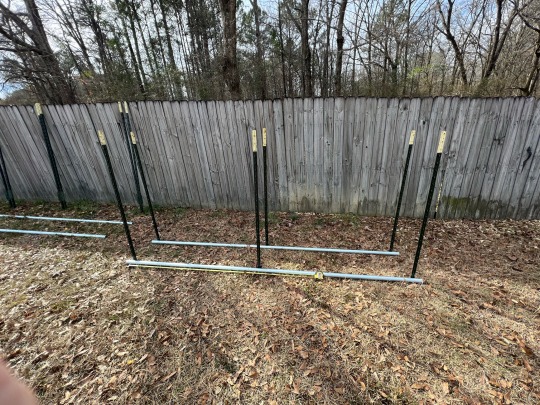

As mentioned, I did move! The bees are still at my old bee yard, but my new place has a nice open yard that I can put them in so I’ll be moving them soon hopefully. I’m setting up bee benches according to a guide I found on YouTube that is all metal and can be adjusted/moved as necessary, because the yard is unlevel everywhere. I tested several positions on each side with my full weight and they seem to hold up quite well. Though I think I may need to adjust some of them because I may have overdone the forward slope a bit. You can really see how uneven the yard is, since the benches are level.
#bees#beekeeper#beekeeping#fox#talks#honeybee#honeybees#honeycomb#honey#bee#hive#hives#langstroth#long langstroth#propolis#comb#apiculture#diy#savethebees#natural#nature#save the bees
56 notes
·
View notes
Photo


Handwritten excerpts from L. L. Langstroth, the Father of American Beekeeping’s, journals on matter’s relating to bees, etc. begun Jan. 29th, 1852 in Philadelphia, Vol. 1- : manuscript 1852-1862. Currently held in our library’s Phillips Beekeeping Collection archive. https://newcatalog.library.cornell.edu/catalog/10018007
#handwriting#vintage journal#vintage handwriting#old handwriting#calligraphy#L.L. Langstroth#beekeeping#bees#bee#swarming#bee swarm#queen bee#honey#beekeeper#bee hive#beehive#entomology#entomologist#handwritten#handwritten journal#cursive#cursive handwriting#chaos#messy handwriting
13 notes
·
View notes
Text

[ Image description: photograph of a device on a hotel breakfast counter. The device is holding a single Langstroth (I think?) frame of honeycomb in an upright position within a glass frame. There is a spout with a wood-handled ball valve in front, and a bowl underneath the spout to capture drips, which is partially filled with golden honey. The frame has no foundation installed, and the comb itself is dark brown and only partially uncapped. A small attached sign reads “Miel - honey”. End ID. ]
I am in Costa Rica on a student tour. In our hotel, there is this thing: I am pretty sure this is a honey subscription service with the Linda Vista Farm (and Apiary, obviously).
Costa Roca is very much into sustainability and eco-tourism, and it shows: to me, this display is perfect, and captures so much information about it in one compact package:
1) The lack of foundation: I think there are wires in their for support, but these bees are not being encouraged to build on foundation. They can do their own thing; imo this is good. Plus, the support that a beekeeper might need to provide if they’re going to extract the honey by spinning the frames is not needed here. You can see the beeways that the bees have built for themselves to transit between combs, which is neat.
2) The color of the wax: fresh wax is light gold in color, so this dark brown wax is old. These frames are being reused, which totally makes sense for a subscription service for this dispenser, and if that’s what they’re doing, I suspect that you just turn in an empty frame for a full one (or maybe you get a whole hive body of 10 frames). The benefit of this for the bees is that they don’t have to rebuild the frames (making wax is metabolically expensive). Cons, though, could be that diseases might be transmitted this way, especially if the frame goes into a different colony’s hive.
3) Most of the cells were uncapped. I think that the hotel staff uncaps sections of the comb as needed, rather than the whole thing at once, which I think would flood the device.
It’s just absolutely brilliant; I cannot stop thinking about it.
If you’re a beekeeper, especially if you’re from Costa Rica and/or know more about La Granja Linda Vista, please reblog and add your thoughts!
2 notes
·
View notes
Text

Source - The honey bee : a manual of instruction in apiculture
by Benton, Frank, 1852-1919
0 notes
Text
The Buzz on Honey Bees and Their Business
The Buzz on Honey Bees and Their Business: Selling Honey Equipment Online
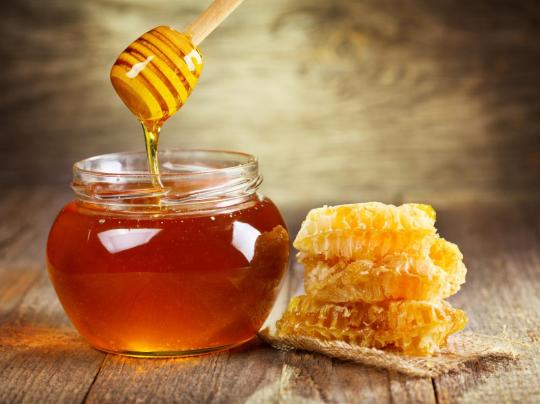
The honey bee, a small insect with a vital role in our ecosystem, has increasingly become the center of attention not just for its environmental significance, but for its burgeoning business opportunities. If you're passionate about honey bees and want to delve into the world of honey-making, then the online market has a plethora of equipment and tools to get you started. From essential beekeeping supplies to those crucial finishing touches like heat shrink bands for jars and bottles, you're just a click away from starting your honey business.
Understanding the Honey Bee Business
Before diving into the types of equipment you can sell online, it's crucial to understand the honey bee business. As these industrious creatures collect nectar, they produce honey—a sweet, golden liquid loved by many. But turning that liquid gold into a market-ready product requires specific tools and techniques.
Essential Equipment for Honey Extraction
Beehives: The primary home for your honey bees. They come in various styles, but the most common are the Langstroth and Top-bar hives.
Bee Suits: These protective suits ensure beekeepers can handle their bees without the risk of stings.

Smokers: Used to calm bees during hive inspections.
Honey Extractors: A device that spins frames, extracting honey without damaging the honeycombs.
Perfecting the Packaging Process
Once you've successfully harvested your honey, the next step is packaging. This is where details like shrink wrap bands for jars come in.
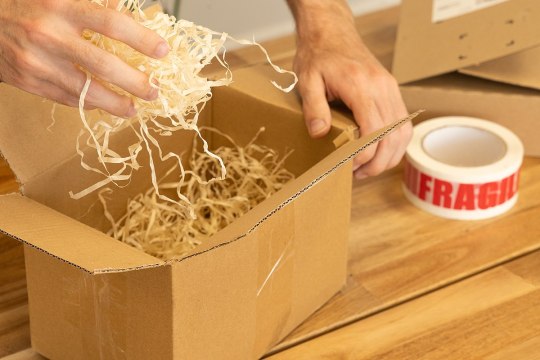
Glass Jars and Bottles: When we muse about honey, the quintessential, timeless packaging we think of? That's right. Glass. They stretch across the spectrum in sizes, some tiny like a delicate thimble, others hefty, holding treasures of amber nectar. Shapes? Oh, they dance from conventional rounds to eclectic hexagons. Catering to the ever-evolving market, they stand resolute, each telling its tale.
Heat Shrink Bands for Jars and Bottles: You've seen heat shrink bands for bottles. Perhaps, without much thought. But, ever think of the genius behind these slender bands? Once dormant, with a hint of heat, they snap into action. Hugging your bottle or jar's neck, they promise safety, scream professionalism. Tamper? Think twice. These heat shrink bands for jars are guardians; their mere presence a challenge to any foul play.

Labels: Imagine walking through an aisle, and a myriad of jars beckon. What makes you pause, tilt your head and reach out? Often, it’s that piece of art draped around the bottle: The label. More than just a sticky piece of paper, it’s a canvas that whispers tales of the golden liquid within. And more than that, it often sings songs of the brand's ethos, legacy, and promises.
Selling Equipment Online:
Fancy a dive into the lucrative world of online honey-equipment sales? A realm awaits. You see, the beekeeper's world isn’t just filled with buzzing. Be it the newbie next door or the seasoned pro from the valley, they’re all scouring for top-notch gear. And while the basics hold their ground, why not sprinkle your inventory with diverse, vibrant heat shrink bands? Every hue, every size. And, to spice things up, keep an eye on the beekeeping vogue. Evolve, adapt, and stay a buzz ahead.
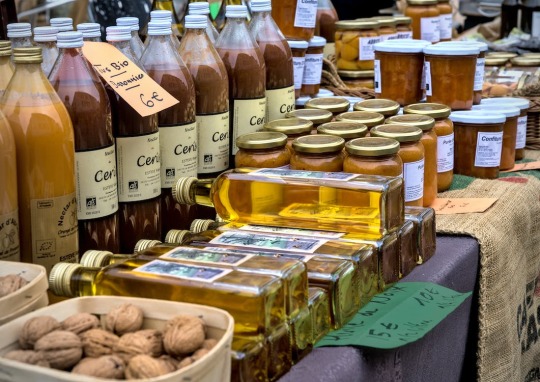
Conclusion:
It’s not just about the hum and the honey. The bee business? It’s a tapestry. Threads of art, science, and commerce intertwining. And as for success? Well, get the gear right. Whether it’s a state-of-the-art extractor or a humble heat shrink band, every cog matters. The golden road to triumph? Just around the corner.
Here's to the art of beekeeping and the sweet symphony it brings! Cheers!
2 notes
·
View notes